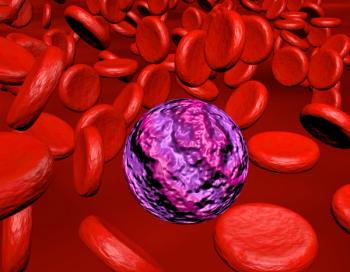
Clofarabine Consolidation May Improve RFS in Younger AML Patients
Three courses of clofarabine combined with cytarabine may improve relapse-free survival in patients with acute myeloid leukemia in first remission.
Three courses of clofarabine combined with intermediate-dose cytarabine (CLARA) may improve relapse-free survival (RFS) in patients with acute myeloid leukemia (AML) in first remission, according to the results of a study
In recent decades, HDAC has been a widely used consolidation therapy for patients with AML; however, according to the study, outcomes after receiving HDAC have been “far from satisfactory.” With this study, Xavier Thomas, MD, PhD, of Lyon-Sud University Hospital in France, and colleagues compared three courses of CLARA with three courses of HDAC as consolidation cycles in younger patients with intermediate- or unfavorable-risk AML who were in first remission.
“The CLARA combination might be considered as a good option for postremission therapy in these patients, especially when a donor for allogeneic stem cell transplantation is not identified at the time when first remission is achieved,” noted the researchers.
The study included 221 patients with AML ages 18 to 59 years who were randomly assigned to three cycles of CLARA or three cycles of HDAC consolidation. The primary endpoint was RFS.
“Because such a study could be difficult to conduct as a result of the confounding effect of allogeneic stem cell transplantation, with a lower treatment effect in patients who receive transplantation, our aim was to provide a signal in favor of the CLARA combination in terms of RFS primarily in patients who have not received transplantation,” explained the researchers.
With a median follow-up of 4.25 years, 57% of patients in the CLARA arm and 61% of patients in the HDAC arm relapsed. Fifty-five patients in each arm ended up undergoing stem cell transplant.
At 2 years, the RFS rate was 58.5% in the CLARA arm compared with 46.5% in the HDAC arm. After adjusting for patients who underwent transplant, the hazard ratio (HR) for CLARA over HDAC before or in the absence of transplantation was 0.65 (95% CI, 0.43–0.98; P = .041). The HR was 0.96 for CLARA compared with HDAC after transplant.
“This effect was mostly related to a reduction in relapse incidence and apparently similarly observed in both intermediate- and unfavorable-risk AML subsets,” wrote the researchers.
The researchers also conducted a sensitivity analysis and found that when patients who received transplant in first remission were censored at transplant time, the 2-year RFS rate was 53.3% for the CLARA arm compared with 31.0% for the HDAC arm (P = .043).
There was no significant gain in overall survival for the two treatment arms, and posttransplant outcomes were similar in patients who were assigned CLARA and those assigned HDAC, in terms of RFS.
Assignment to the CLARA arm was associated with higher hematologic and nonhematologic toxicities compared with HDAC.
“Myelosuppression was much deeper and longer, and severe nonhematologic toxicities more pronounced after CLARA,” wrote the researchers. “However, safety of the CLARA combination seemed acceptable, and differences observed in toxicities did not translate into a higher incidence of death in remission.”
Newsletter
Stay up to date on recent advances in the multidisciplinary approach to cancer.

















































































